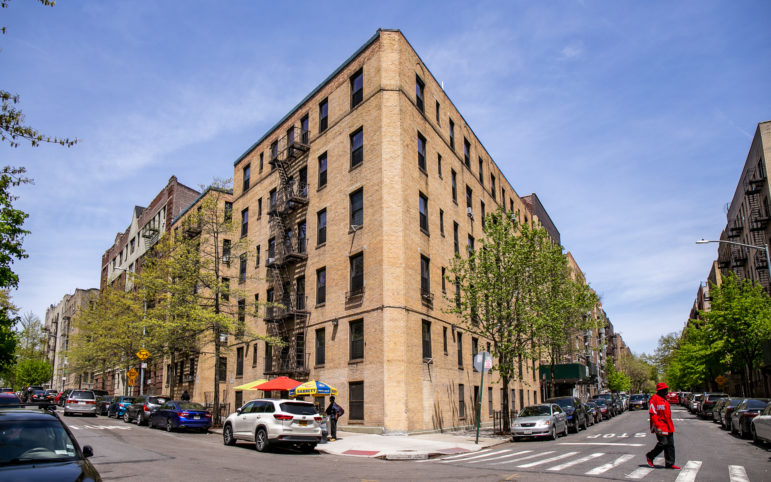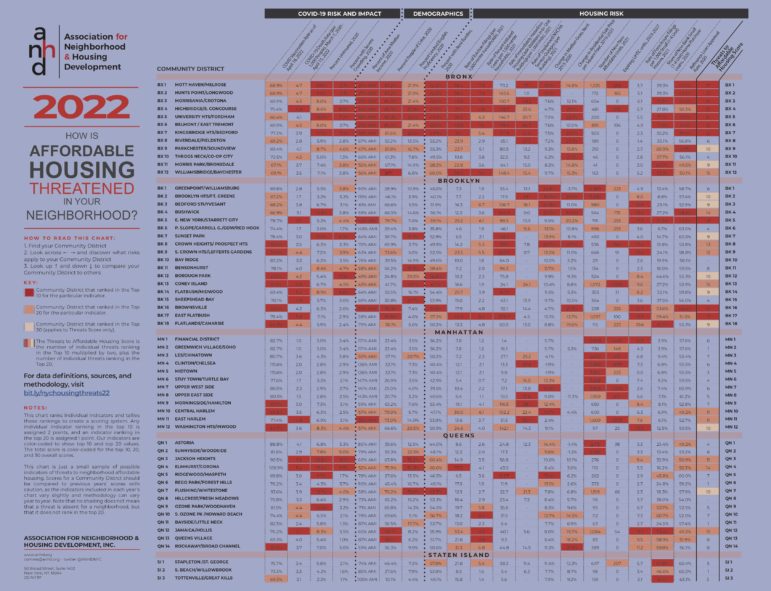“ANHD’s 2022 Housing Risk Chart highlights the compounding pressures, and risks, to affordable housing in dozens of neighborhoods. Indicators of speculation, gentrification, and displacement pressure are distributed throughout the city and show the necessity of tenant and homeowner counseling and support programs that defend affordability in every neighborhood.“

Adi Talwar
A Bronx residential building on the corner of West Mosholu Parkway North and Knox Place.COVID has made clear the primary actors for getting service and aid and for stabilizing our neighborhoods are local community partners. Throughout COVID, community development corporations (CDCs) and community-based organizations (CBOs) have amplified their roles as community caretakers, standing on the front lines to ensure tenants and small homeowners can stay in their homes amidst a pandemic.
The pandemic has also highlighted how this critical work and assistance is deeply underfunded and—given the moment—requires special attention; namely, renewing and expanding funding for the Community Housing Preservation Strategies Initiative (CHPSI).
Thursday, ANHD released our 2022 Housing Risk Chart: How is Affordable Housing Threatened in Your Neighborhood?, with new data on New York City’s housing crisis, reinforcing the need and highlighting the work ahead for CDCs and CBOs. ANHD’s data visualization demonstrates the diverse and multifaceted threats to housing stability for communities of color, low-income communities, immigrants, and other marginalized communities.
In the Bronx, most risk indicators were consistently high for the majority of community districts; these include rate of uninsurance, low area median income (AMI), percent of people who are rent-burdened, rate of tenant-initiated housing court cases, rate of immediately hazardous housing code violations, rate of unplanned NYCHA service outages, and low refinance loan approval rates. Those same districts have high percentages of people of color, and people with limited English proficiency.
Rates of immediately hazardous housing code violations, rates of foreclosure filings in small homes and low vaccination rates were particularly concentrated in Brooklyn districts.
The number of new non-affordable units and expiring Low-Income Housing Tax Credit units are highly concentrated in Manhattan, indicating that an already unaffordable borough is becoming even more inaccessible to lower-income New Yorkers.
Rates of death from COVID-19, rates of uninsurance, limited English proficiency, and tenant-initiated cases were the most concentrated risks across four Queens districts: Jackson Heights, Elmhurst/Corona, Jamaica/Hollis. Flushing/Whitestone. There were also high rates of non-bank home purchase loans and low refinance loan approval rates in many Queens districts.
Staten Island’s Stapleton/St. George sections, which have the lowest AMI and largest share of people of color, ranked in the top 20 for three additional housing risk factors: percent with rent burden, rate of tenant-initiated housing court cases, and expiring Low Income Housing Tax Credit (LIHTC) units.
I hope you will take a look at ANHD’s comprehensive chart with 19 ranked indicators of risk to housing stability, as well as our key takeaways here. It clearly captures that the need for comprehensive and targeted affordable housing support services is skyrocketing.
For the past 15-plus years, the New York City Council has supported the Community Housing Preservation Strategies Initiative (CHPSI) to ensure CDCs and CBOs across the city’s community districts can work on a neighborhood level to combat the loss of affordable housing in their community. CHPSI supports the housing works our communities need—tenant organizing, code enforcement, housing court assistance, apartment repossession, and other housing-related public education needed unique to each neighborhood.
The ANHD Housing Risk Chart reinforces that as we head into a long recovery—which will continue to be more challenging for communities of color, low- and moderate-income communities and immigrant communities—we need increased support and services to do what is necessary.
This is why ANHD and 40-plus CDCs and CBOs are calling on the New York City Council to renew the Community Housing Preservation Strategies Initiative at $4.36 million in the Fiscal Year 2023 budget. Funding at this increased level will ensure every Council district has targeted support services to the threats impacting their affordable housing stability.
Barika X. Williams is the executive director of the Association for Neighborhood and Housing Development, which builds community power to win affordable housing and thriving, equitable neighborhoods for all New Yorkers. As a member organization of community groups across New York City, ANHD uses research, advocacy, and grassroots organizing to support their members in their work to build equity and justice in their neighborhoods and citywide. ANHD believes housing justice is economic justice is racial justice.










2 thoughts on “Opinion: NYC Communities of Color Face Increased Eviction Filings, Displacement Risk, and Soaring Unaffordable Rents ”
There is continuous neighborhood and community destruction throughout NYC. In Brooklyn every empty space is developed. without coherent planning. Manhattan is overdeveloped and without history.
Politicians are in the pocket of developers. Trendy magazines pitch Bedford Stuyvesant to white folk. People I know who are African Americans and Caribbean Americans feel pushed out. There is ruthless domination of city by. Real Estate interests.
.
Stop. Mayor Adams is worried about black property owners. People are people